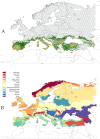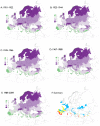The Impact of Climate Trends on a Tick Affecting Public Health: A Retrospective Modeling Approach for Hyalomma marginatum (Ixodidae)
- PMID: 25955315
- PMCID: PMC4425654
- DOI: 10.1371/journal.pone.0125760
The Impact of Climate Trends on a Tick Affecting Public Health: A Retrospective Modeling Approach for Hyalomma marginatum (Ixodidae)
Abstract
The impact of climate trends during the period 1901-2009 on the life cycle of Hyalomma marginatum in Europe was modeled to assess changes in the physiological processes of this threat to public health. Monthly records of temperature and water vapour at a resolution of 0.5° and equations describing the life cycle processes of the tick were used. The climate in the target region affected the rates of the life cycle processes of H. marginatum: development rates increased, mortality rates in molting stages decreased, and the survival rates of questing ticks decreased in wide territories of the Mediterranean basin. The modeling framework indicated the existence of critical areas in the Balkans, central Europe, and the western coast of France, where the physiological processes of the tick improved to extents that are consistent with the persistence of populations if introduced. A spatially explicit risk assessment was performed to detect candidate areas where active surveys should be performed to monitor changes in tick density or persistence after a hypothetical introduction. We detected areas where the critical abiotic (climate) and biotic (host density) factors overlap, including most of the Iberian peninsula, the Mediterranean coast of France, eastern Turkey, and portions of the western Black Sea region. Wild ungulate densities are unavailable for large regions of the territory, a factor that might affect the outcome of the study. The risk of successfully establishing H. marginatum populations at northern latitudes of its current colonization range seems to be still low, even if the climate has improved the performance of the tick in these areas.
Conflict of interest statement
Figures





References
-
- Pearson RG, Dawson TP (2003) Predicting the impacts of climate change on the distribution of species: are bioclimate envelope models useful?. Global Ecol Biogeogr 12: 361–371.
-
- Peterson AT, Martínez-Campos C, Nakazawa Y, Martínez-Meyer E (2005) Time-specific ecological niche modeling predicts spatial dynamics of vector insects and human dengue cases. Trans Royal Soc Trop Med Hyg 99: 647–655. - PubMed
Publication types
MeSH terms
LinkOut - more resources
Full Text Sources
Other Literature Sources

